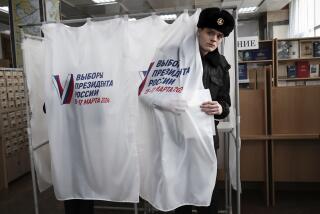Chief Reformist Warns Ruble May Collapse
- Share via
MOSCOW — The architect of Russia’s transition to a market economy, fighting for his reforms and his job, told hostile lawmakers Wednesday that the national currency is on the verge of collapse and could not withstand a wholesale government rescue of failing industries.
Defending his Western-backed campaign to end seven decades of Communist central planning, Acting Prime Minister Yegor T. Gaidar admitted that the year-old effort has been stalled by steep recession and high inflation but argued that most Russians support it.
“Last autumn, there was talk of cold and hunger, the stoppage of transport, but none of that happened,” Gaidar declared, recalling the dark warnings for Russia as the Soviet Union crumbled. “We have gone through this period of adjustment with no social upheavals. . . . The people clearly understand the need for reforms and are ready to work.”
Before Gaidar in the Grand Kremlin Palace’s huge marble-columned chamber, jeering at times, sat his harshest critics: middle-aged former Communists who are pressing for a wage-price freeze and major subsidies to the military-industrial complex they still control.
“We stand on a very narrow path,” he warned them, gripping the sides of the wide lectern, which still bears the hammer-and-sickle seal of the Soviet Union. “We can get out of the crisis only if we go along this path very carefully. It is very easy to skid from this narrow path.”
The second day of raucous, wide-ranging debate by the 1,041-member Congress of People’s Deputies, elected before the Soviet breakup, offered what may be the decisive report card on Gaidar’s economic stewardship.
Having ruled out impeaching Russian President Boris N. Yeltsin, the congress is expected to strip him of his decree-making power and force him to nominate a prime minister for its ratification. Yeltsin’s advisers admitted that Gaidar’s ability to win over the industrialists’ Civic Union, the congress’ pivotal centrist bloc, is doubtful--despite some concessions to select industries.
Gaidar, for example, said that Russia--despite international concern--will continue to produce for the lucrative international arms market. He mentioned recent arms sales of $1 billion to China, $600 million to India and deliveries to Syria and Iran; Tehran recently received a Russian submarine.
As for Gaidar’s survival, Civic Union leader Nicolai Travkin said: “A prime minister must be a guarantor that the country is moving forward. The country has not been moving forward. It has been shaking from side to side.”
Gaidar, 36, a rotund economist with a boyish, rumpled look, launched the reforms last January by freeing price controls and abolishing the Soviet central planning agency. Armed with $24 billion in pledges of Western aid, he proceeded in June to lift government barriers to private business activity and to sell off state-owned enterprises to investors.
In some ways, the reforms have advanced beyond the point of no return. Russians have adopted a market mentality with gusto, buying up 24,000 state enterprises and 156,000 state farms. They are learning how to make money in a freer economy.
“People began to realize that the state will no longer take care of them and their future,” said Boris Nemtsov, the mayor of Nizhny Novgorod, whose city government has already privatized 1,000 shops and 8,500 trucks. “This understanding is revolutionary.”
But Russia’s leap to capitalism is proving to be more painful, protracted and politically contentious than most people here expected. Among the frustrations debated in the congress:
* Price freedom has not led suddenly to competition and lower prices. Instead, many factory directors managed to preserve their Soviet-era monopolies, raised prices, let unsold goods pile up in warehouses and borrowed money from one another, creating a huge chain of debts. Production plummeted. “The plague of the Russian economy remains super-monopolism,” Yeltsin complained to the congress on Tuesday. “All measures to curb it have been ineffective.”
* While the World Bank estimates that the reforms require $20 billion a year, Russia has received just $9.5 billion of the promised $24 billion in aid from the West. Jeffrey Sachs, an American economic adviser to the Russian government, criticizes not only the slowness of the aid but the lack of Western conditions obliging Russia to restructure its economy. “We have failed terribly this year,” he said in an interview.
* Corruption has bled the government. Vice President Alexander V. Rutskoi gave this example: Russia is spending $344 million this year on meat imports--the cost of building eight meatpacking plants at home. One possible reason: A group of Foreign Trade Ministry officials managed to pocket $13.5 million in kickbacks before they were caught. “This is why our policy is so inflexible,” he told the congress. “It is designed to rob Russia, not to consolidate its strength.”
* The gap between nouveau riche capitalists and Russia’s poor is growing as a cradle-to-grave welfare system inherited from the Soviet Union falls apart. “The number of homeless children is growing, something we haven’t been worried about before,” said Ella A. Pamfilova, Russia’s social protection minister. “The birthrate is falling rapidly and going below the death rate. Many children are now born sick.”’
Still, Russians are not starving. There are adequate supplies of food in the stores and a bountiful grain harvest of 109 million metric tons--14 million more tons than last year--is on the way.
By far the biggest setback for Gaidar’s reforms has been his costly battle with the powerful industrial sector and its allies in the central bank, who issued $5 billion this year to shore up cash-strapped factories.
The credit flow, begun in June by a parliamentary appointee, over Gaidar’s objections, wrecked his tight fiscal policy and set off a damaging burst of inflation. The credits were slowed in October, but prices are still rising by 25% a month. Many Russians’ life savings have been wiped out.
Russia’s free-floating ruble--trading at 113 to the dollar in June--has plunged to 425 to the dollar currently. The fiscal deficit has soared to 10% of the country’s gross national product, double the ceiling set by the International Monetary Fund on behalf of Western aid donors.
Consumer spending has shrunk by half and the economy as a whole by 20%. Unemployment is still low--there are 442,000 jobless, or about 1.5% of the work force. But at the same time, millions of workers have been ordered to take unpaid vacations or halve their hours as factories scale back production.
Amid such difficulty, public support for the reforms has waned. An independent poll of Muscovites, aired Nov. 27 by the weekly television show “Itogi,” showed 31% favored Gaidar’s economic program, against 14% for rival plans; 30% opposed Gaidar’s program but didn’t support an alternative, and 25% did not answer.
In his speech Wednesday, Gaidar accepted responsibility for the credit crunch that prompted the inflationary credits. But he insisted on reining in the money supply, saying Russia is too close to hyper-inflation that might drive the ruble out of circulation.
Even so, he reaffirmed the outlines of a four-month plan of “anti-crisis” subsidies, drawn up with help from the Civic Union, to help Russia get through the winter without a significant rise in unemployment. The plan calls for selective credits to shore up such critical sectors as oil production and agriculture and to help Russia’s mammoth defense establishment convert to civilian production.
Whether or not these concessions are enough to save Gaidar’s job, they indicate a new willingness to make accommodations that would have been unthinkable earlier.
Andrei Ostroukh and Sergei Loiko of The Times’ Moscow bureau contributed to this report.
More to Read
Sign up for Essential California
The most important California stories and recommendations in your inbox every morning.
You may occasionally receive promotional content from the Los Angeles Times.









